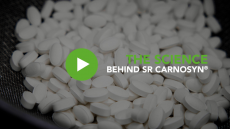Gene reveals high-risk osteoporosis group
increase susceptibility to osteoporosis, a new study reveals.
Researchers at Washington University School of Medicine in St. Louis demonstrated that in women the variant gene speeds up the breakdown of oestrogen and is associated with low density in the bones of the hip.
The findings, to be reported in the February issue of the Journal of Bone and Mineral Research 20(2), pp 232-9, suggests that future methods of prevention of the disease, largely through sufficient intake of calcium and other nutrients, could be targeted to certain individuals.
The use of genetics to personalise nutrition is set to become increasingly important in the future. Early signs of the development of personalized nutrition have already been reflected in the partnership between BASF and Fonterra, set up to create vending machines for customized health products.
Advances in genetics could allow for more successful prevention of some of today's chronic diseases, responsible for the majority of deaths in the developed world.
Osteoporosis is second only to cardiovascular disease in terms of global health care problems, according to the World Health Organisation, and currently affects some 200 million people. The number of sufferers is however set to increase steadily with growing numbers of elderly living longer, and obesity adding extra strain on bones.
In the UK, health and social care for osteoporosis patients already costs the taxpayer around £1.7 billion per year, according to the Department of Health.
Given the seriousness of the disease, it would be very advantageous to identify those people at especially high risk, say the Washington researchers, who may have found an important genetic marker for evaluating that risk.
"Ideally, you want to start early to avoid osteoporosis," said Dr Reina Armamento-Villareal, assistant professor of medicine in the Division of Bone and Mineral Diseases.
The team discovered that a gene named CYP1A1 makes an abundant enzyme that detoxifies foreign substances and also breaks down oestrogen as a normal part of maintaining oestrogen balance.
Within the general population, several variations of the CYP1A1 gene exist, and the variants differ from one another by one or more DNA base pairs.
"Previous studies showed that some CYP1A1 variants are linked to oestrogen-related cancers, such as breast, ovarian or endometrial cancers," said the lead author.
"The link to oestrogen suggested that the gene could also affect bone density. No one had ever investigated that possibility, so we set up a study to evaluate the relation between bone density and variations of the CYP1A1 gene."
The researchers studied 156 women with an average age of 63.5 years who were at least one year past menopause. They analyzed the genetic sequence of each woman's CYP1A1 gene to identify which of the genetic variants they possessed.
One of the variations of the gene, known to be present in 19 per cent of the general population, was found in women who had significantly lower blood oestrogen levels and higher levels of urinary oestrogen breakdown products than normal.
These women also had a higher than normal urinary concentration of a marker that indicates bone resorption and had significantly lower than normal bone density in regions of the upper femur near the hip joint.
"The data suggest that this particular variation of the gene produces an enzyme that breaks down oestrogen faster than usual, leading to low serum oestrogen levels and high levels of oestrogen metabolites," Villareal said.
"Low levels of oestrogen put a woman at risk for osteoporosis, and our data showed a strong correlation between the genetic variant and low bone density."
The study also found that this genetic variant specifically affects the hip bones, a major site for osteoporotic fracture.
"Our next study will look at a much younger group of women. My guess is that we will find that females with this variant gene are breaking down oestrogen rapidly from the day they are born. In that case, they would never achieve an adequate peak bone density and would lose even more bone mass after menopause," said Villareal.
Catching this group early could maximize their chances to avoid osteoporosis.












